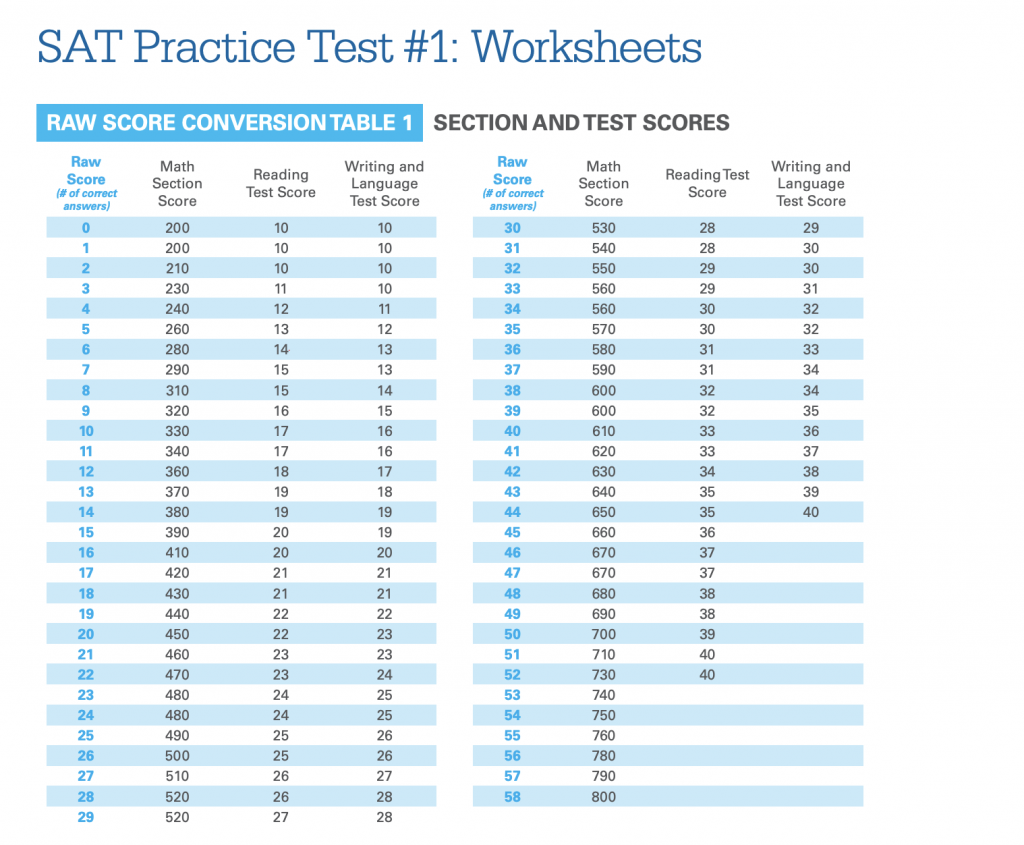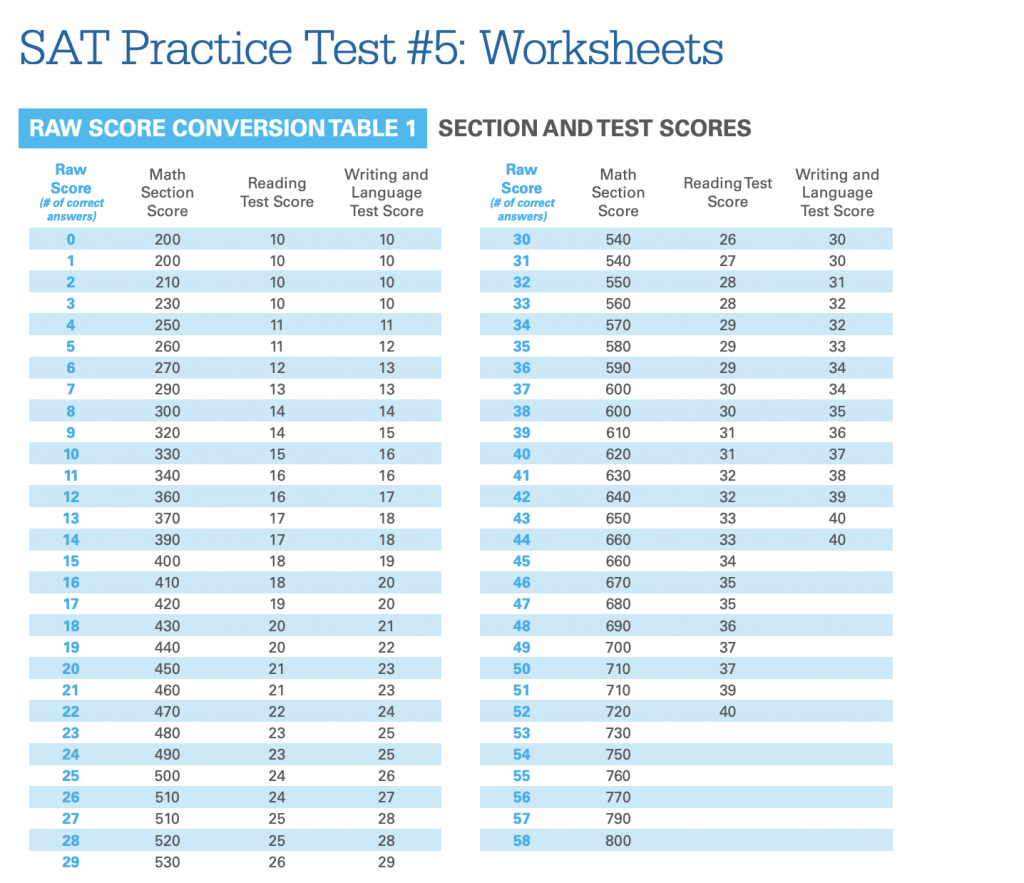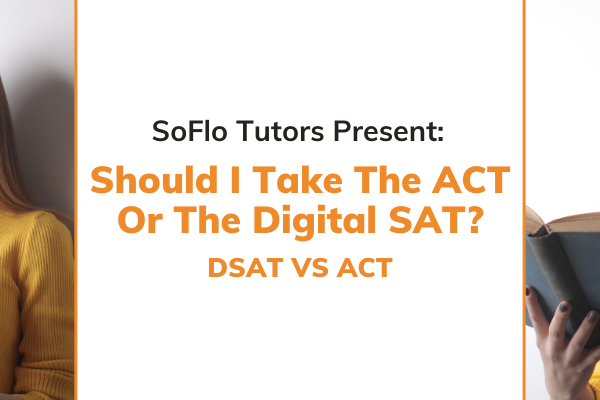
A guide to understanding how scoring works on the Evidence-Based Reading and Writing Sections of the SAT.
What is the Evidence-Based Reading and Writing Section?
Thousands of students submitting college applications take the SAT. The Evidence-Based Reading and Writing section comprises half of the SAT exam. As the name suggests, the Evidence-Based Reading and Writing section really consists of two smaller sections: the Reading section (more formally known as Evidence-Based Reading by the CollegeBoard) and the Writing and Language section. Together, these two smaller sections can really be thought of as the “verbal” half of the SAT. The rest of the exam are two math test sections. Here’s some more information as to what you can expect in the two subsections of the Evidence-Based Reading and Writing section:
The Reading section tests students’ abilities in reading comprehension and command of evidence. Specifically, questions in this section will ask students to identify the main idea of a passage, recall details, and define vocabulary words. Students will have sixty-five minutes to read five sets of passages and answer fifty-two questions in this section.
The Writing and Language section will not ask students to do any actual writing of their own, but rather to fix mistakes in a passage. Questions test students’ abilities in correcting specific English grammatical mistakes, adhering to standard English conventions as well as in maintaining the flow of a passage. Students will have thirty-five minutes to answer the forty-four questions in this section.
How is the Evidence-Based Reading and Writing Section scored?
The SAT is scored out of a total score of 1600. Within this 1600, there are two section test scores – also called subscores – for the Evidence-Based Reading and Writing and Math sections out of 800. The lowest possible score for each section is 200. This means that if you get absolutely nothing correct in a section, your section score will be 200. These raw scores are then converted into percentiles, a number between 1 and 100, which let you know how you did compared to everyone else who took the test. Check out this article to learn more about percentile rankings and how they are calculated.
The Evidence-Based Reading and Writing section is scored slightly differently than the Math section of the exam, despite both sections being out of a possible 800. The SAT Math section is scored by converting one raw score to one scaled score. The Math section score comes from the sum of the number of correct answers across the No Calculator and Calculator math sections. This raw score is then converted to a scaled score out of 800. The more questions you get correct, the higher the raw score, and the closer you get to 800. Getting all questions correct in the Math section will ensure an 800, but sometimes particular tests have relatively more leeway, meaning there are some tests where you can get a question wrong and still get an 800. This variation between different SATs is something that will be discussed in greater detail later on.
The Evidence-Based Reading and Writing section score come together from two smaller scores. Unlike in the Math section, where the raw score comes from a sum of the number of correct answers in the no calculator and calculator sections, the raw scores for the reading and writing and language test sections are kept separate. There is one raw score based on the number of correct answers for the reading test section, and similarly a raw writing score. Then, using a score conversion table, the two raw scores are calculated into separate scaled scores. Instead of being out of 800 like with math, the reading and writing and language scaled scores are each out of 40. Finally, the scaled scores from reading and writing are added together and multiplied by 10 to get a score out of 800.
This can be tricky, so here’s an example using the scoring conversion table from Official CollegeBoard Test 7.
On this test, if a student gets 42 questions right on the reading section, this raw score converts to a scaled score of 33. If the student gets 37 questions correct on the writing and language section, this converts to a scaled score of 34. Adding these individual scaled scores together gives a combined scaled score of 67. Multiplying this combined scaled score by 10 gives a final section score of 670 out of 800 possible points.
Are all Evidence-Based Reading and Writing sections scored the same?
No, not all Evidence-Based Reading and Writing sections are scored the same. There is variation in how different SATs are scored, and there is no way to tell how any particular SAT will be scored ahead of time. This means that even if you always get the same number of questions correct in the Evidence-Based Reading and Writing section, your scaled score will vary across tests.
Luckily, the SAT gives you points for every correct answer and does not penalize you for incorrect answers (the old SAT that was administered prior to 2016 used to take off ¼ of a point for every incorrect answer you bubbled). If you get every question correct in the Evidence-Based Reading and Writing section correct, you can always expect an 800 for your Evidence-Based Reading and Writing section score. However, if you get a question wrong, it’s hard to definitively say what effect this will have on your score. Because each SAT varies in what is called a score conversion, there is variation between the scaled score for any given raw score. For example, let’s compare the scoring tables of the following two exams, Official CollegeBoard Test 1 and Official CollegeBoard Test 5:


As expected, getting everything right on the reading and writing sections will give you a perfect section score. But notice the variation in the scaled scores that begins as soon as a student misses one question. A student who misses one question in the reading section in Practice Test 1 is still able to get a scaled score of 40, meaning they still have a chance at a perfect Evidence-Based Reading and Writing section score assuming they get everything right in the writing and language section. However, a student who misses one question in the reading section in Practice Test 5 will receive a scaled score of 39. Assuming they get everything right in writing, at most they will be able to get an Evidence-Based Reading and Writing section score of 790. The same thing happens in writing and language! A student who misses a question in the writing section of practice test 1 will receive a scaled score of 39, while a student who misses a question in the writing section of practice test 5 gets a perfect scaled score of 40.
Tests that have been administered in real-world settings have variation across their score conversion, too. One of the tests most notorious for a difficult score conversion is the June 2018 test. One question wrong on the math section of the June 2018 test resulted in a section score of 770. For comparison, three questions wrong on the math section resulted in a section score of 790 on the March 2018 test, which was surely a much more generous test. Unfortunately, there is no accurate way to predict how tests will be scored in advance, so there certainly is some luck involved in your score. If you’re interested in looking at how scoring varies on different tests, check out this link.
That being said, looking at both charts, you generally will notice that for each additional question correct, the scaled scores in both the reading and writing sections tend to go up by about one point (and vice versa, down by about one point for each incorrect answer). Remember that we multiply our Evidence-Based Reading and Writing scaled score by ten to get the actual section score. This means that while there’s no way to predict what your exact SAT score will be from any given raw score, you generally expect each additional correct answer to earn you an extra ten points (and each incorrect answer brings you down by about ten points from a perfect 1600).
Note that while the score conversion varies across tests, the score conversion is not the same thing as a curve. The way a particular SAT will be scored is predetermined by the CollegeBoard before a test is ever officially administered (although this information is not released prior to the test), and the scoring will not vary based on students’ performance, as a traditional curve in school does. Even if most students do relatively poorly on a section, the scoring will not be adjusted.
What’s the average score?
For the class of 2021, the average score on the Evidence-Based Reading and Writing section was 533. This is five points higher than the average score for the Math section. Judging by the score conversion tables included above, and assuming about a similarly scoring performance on the reading and writing and language sections, in order to get around a 533 in Evidence-Based Reading and Writing students will need to get around 27 questions right in both the reading and writing and language sections. Students should look into the score ranges of the average admitted student in the colleges they are specifically applying to, however, as the average score is just a benchmark of how you do compared to all the other students taking the test. Different schools have varying college admissions requirements and will be comparing you to their specific application pool.
As can be expected, this score varies greatly based on various factors, including a student’s year in high school, demographic factors, and performance in school. Here’s a look at how the average Evidence-Based Reading and Writing section score varies based on the GPA for 11th graders from the CollegeBoard’s 2021 Annual Report:
| Average GPA | Number of Students | Percent | Average Evidence-Based Reading and Writing Score |
| A+ (97-100) | 75,705 | 8% | 576 |
| A (93-96) | 188,540 | 20% | 542 |
| A- (90-92) | 131,453 | 14% | 504 |
| B (80-89) | 197,747 | 21% | 457 |
| C (70-79) | 52,745 | 5% | 409 |
| D, E, or F (below 70) | 8,368 | 1% | 393 |
| No response | 308,228 | 32% | 462 |
SoFlo SAT Tutoring
At SoFlo, our tutors understand how difficult it can be to get a top score on the SAT. Our tutors are expert test-takers who’ve all mastered the test and are enthusiastic to help students reach the best score they can on test day. If you want tailored test prep to boost your score on the Evidence-Based Reading and Writing section, check out our personal tutoring services here.
About the Author
Ava Levine is a junior from New York majoring in International Studies at Johns Hopkins University. When she’s not in class studying various international issues, she enjoys learning about government policy and working with local nonprofits. She scored a 1570 on her SATs, is an avid Crocs-wearer, and loves to craft in her free time!










